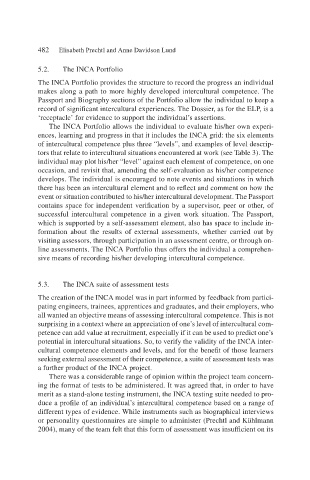Page 504 - Handbooks of Applied Linguistics Communication Competence Language and Communication Problems Practical Solutions
P. 504
482 Elisabeth Prechtl and Anne Davidson Lund
5.2. The INCA Portfolio
The INCA Portfolio provides the structure to record the progress an individual
makes along a path to more highly developed intercultural competence. The
Passport and Biography sections of the Portfolio allow the individual to keep a
record of significant intercultural experiences. The Dossier, as for the ELP, is a
‘receptacle’ for evidence to support the individual’s assertions.
The INCA Portfolio allows the individual to evaluate his/her own experi-
ences, learning and progress in that it includes the INCA grid: the six elements
of intercultural competence plus three “levels”, and examples of level descrip-
tors that relate to intercultural situations encountered at work (see Table 3). The
individual may plot his/her “level” against each element of competence, on one
occasion, and revisit that, amending the self-evaluation as his/her competence
develops. The individual is encouraged to note events and situations in which
there has been an intercultural element and to reflect and comment on how the
event or situation contributed to his/her intercultural development. The Passport
contains space for independent verification by a supervisor, peer or other, of
successful intercultural competence in a given work situation. The Passport,
which is supported by a self-assessment element, also has space to include in-
formation about the results of external assessments, whether carried out by
visiting assessors, through participation in an assessment centre, or through on-
line assessments. The INCA Portfolio thus offers the individual a comprehen-
sive means of recording his/her developing intercultural competence.
5.3. The INCA suite of assessment tests
The creation of the INCA model was in part informed by feedback from partici-
pating engineers, trainees, apprentices and graduates, and their employers, who
all wanted an objective means of assessing intercultural competence. This is not
surprising in a context where an appreciation of one’s level of intercultural com-
petence can add value at recruitment, especially if it can be used to predict one’s
potential in intercultural situations. So, to verify the validity of the INCA inter-
cultural competence elements and levels, and for the benefit of those learners
seeking external assessment of their competence, a suite of assessment tests was
a further product of the INCA project.
There was a considerable range of opinion within the project team concern-
ing the format of tests to be administered. It was agreed that, in order to have
merit as a stand-alone testing instrument, the INCA testing suite needed to pro-
duce a profile of an individual’s intercultural competence based on a range of
different types of evidence. While instruments such as biographical interviews
or personality questionnaires are simple to administer (Prechtl and Kühlmann
2004), many of the team felt that this form of assessment was insufficient on its

